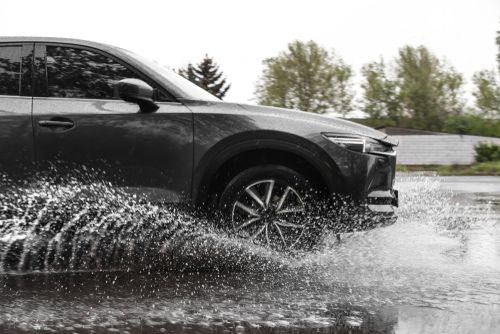We all know that driving during a heavy downpour can be dangerous. Flooding is a risk, visibility could diminish greatly, and you may also experience the phenomenon known as hydroplaning.
You may have heard about that last term before, but you may not be fully aware of what happens to your vehicle as you experience it. This article will aim to change that by telling you all you need to know about hydroplaning. It will also include some valuable tips that should help you avoid that potentially dangerous occurrence.
Without further ado, let’s go in-depth on the topic of hydroplaning.
What Is Hydroplaning?
Hydroplaning, which people also refer to as aquaplaning, is a phenomenon that can present a lot of danger to anyone on the road when it happens. Those who have not experienced it before may think that it’s kind of like a car slipping on the road, but there’s more to it than that.
If a vehicle hydroplanes, that means its tires are no longer making contact with the road.
At first, the front tires will ride up on to some wedges of water. This occurrence could produce a strange noise. As the automobile continues to hydroplane and the rear tires make it to the top of the water as well, you will start to lose control.
As you can imagine, losing control can be dangerous. You could end up veering off the road. From there, you may tumble or crash into something before coming to a full stop.
Notably, you can do something to prevent hydroplaning and at least try to protect yourself. We’ll get to that later in the article.
Before that, we will discuss why hydroplaning happens.

What Is the Process That Leads to Hydroplaning?
Vehicles need what is known as rolling traction to move along the road. When conditions are dry, your tires have no trouble establishing that rolling traction.
Things change when water is in the equation.
Your tires will have a harder time getting planted on the road with water blocking the way. Most of the time, your tires can still displace the water and reach down to make contact with the solid ground.
In some cases, though, the tires may not have enough time to displace the water. Instead, the water makes its way beneath your tires. Too much water accumulating beneath your tires is bad news.
Once there is enough water under your tires, it will lift them off the ground. Essentially, your vehicle is no longer making contact with the ground. In those few fleeting moments, you are now in the driver’s seat of what is effectively a big hunk of metal skidding along the surface of the water.
Technically, you should still control different parts of your vehicle even in the middle of hydroplaning, but what you’re doing may not make much of a difference if the wheels are not touching the road.
What Are the Factors That Can Cause Hydroplaning?
We know that water on the road is a contributor to aquaplaning, but it’s important to note that risk levels change depending on certain factors related to the water.
The Water Level
The depth of the water on the road is something that can play a huge role in whether or not your car hydroplanes or goes over the wet surface with relatively no trouble. If the amount of water on the road is equal to or deeper than one-tenth of an inch, that could spell trouble for your vehicle.
So, are you good to go if you’ve only had light rain in your area? That’s not necessarily the case either.
The small amount of water by a light rain can still combine with other liquid residue remaining on the road. That mixture of liquids can force your tires to rise, thus leading to them to separate from the ground.
Your Vehicle’s Speed
How fast you are going when you contact the water on the road can have a say in whether or not it hydroplanes. If you are going too fast when your auto hits the water, the tires may not have enough time to displace the liquid.
The wheels need at least a small window of time to displace the water. When they don’t get that, hydroplaning occurs.
Your Vehicle’s Weight
Having a bigger vehicle can be beneficial when you’re driving along water-covered roads because the weight of your vehicle will help with displacing the water.
The Distance Traveled by Your Vehicle
Aquaplaning usually starts with the front wheels of your vehicle lifting off the road. The water will need more time to work on the rear tires. The longer the distance you travel with your front wheels elevated by the water, the greater the chances of hydroplaning taking place.
The Characteristics of Your Tires
Your tires can play a significant part in your vehicle hydroplaning.
Tires with a wider tread are more susceptible to hydroplaning because of the larger surface area. Having that much surface area available means the water will have more time to form into a wedge and eventually separate your vehicle from the ground.
You also need to take the depth of the tire’s tread into consideration before deciding if you want to head out for a drive in wet conditions. The wheels that lack enough tread depth are more likely to contribute to hydroplaning.
What Are Preventative Measures You Can Take to Keep Your Car from Hydroplaning?
Hydroplaning carries a real risk of injury. Your insurance may also need to foot a hefty medical bill while forking over cash to pay for property damage your vehicle may have caused.
Even if you manage to emerge from the accident relatively unscathed, you could still face some serious problems.
You want to avoid hydroplaning at all costs. Included below are some of the preventative measures you can take to make a drive during rainy conditions safer.
Do Something about Your Tires
Considering that hydroplaning occurs when something goes wrong with your tires, it’s a good idea to check them.
Start by inspecting the tread depth of your tires. The good news is that you don’t need to take your car into the auto shop to do that. A simple test will do fine.
To measure the tread depth, you can start by pulling out a penny. Make sure that Abraham Lincoln’s head is upside down and that you can see it easily. Insert the penny into the tread of the tire and check to see how far it goes.
You’ll know your tires are good if the tread obscures President Lincoln’s forehead. If his head is completely visible, that means your tires are too worn down and will be risky to use on wet roads.
Replacing them is a good move at that point.
While you’re inspecting the tires, go ahead and see you have them inflated properly. Proper inflation will help your tires more effectively fend off the water on the road.
For those with some extra money to spend, it’s worth looking into purchasing tires that are better for watery conditions. You can now find tires that feature special tread patterns. These tread patterns will make it easier for the tires to maintain contact with the road.
Check Out any Road Advisories
We’ve already noted that both heavy and light rain can contribute to hydroplaning. You can run into trouble regardless of how hard the rainfall is.
Still, it helps to check any road advisories for the route you are planning to take. You may find alerts for dangerous puddles that have formed.
By knowing which roads, you can and cannot take, you can out a better route to your destination.
Employ Safe Driving Techniques
The way you drive when there’s water on the road can save you from an aquaplaning incident.
First off, you should not even consider using your vehicle’s cruise control feature if you know there’s a significant amount of water on the ground.
Hydroplaning can happen in an instant. With your car in cruise control, you may not be quick enough to prevent the hydroplaning from getting worse. Always stay safe by maintaining full control of your car as you navigate the potentially dangerous roads.
Slowing down is also advisable if you are planning to drive along slippery roads. Remember that your tires need to have enough time to displace the water they encounter, and you can help with that by maintaining a lower speed.
Make sure your vehicle does not go over 50 miles per hour when water covers the road. If possible, keep your speed to somewhere between 30 to 35 miles per hour to be even safer.
Your fellow drivers can help you stay safe on the road as well. While driving, look for the tracks left behind by other drivers and try to follow them as closely you can. These tracks are not covered by as much water as the rest of the road so your tires will likely have an easier time on them.
Lastly, try to avoid making sharp turns while on wet roads. It’s easier to lose traction when you execute those turns, and that makes your vehicle vulnerable to hydroplaning.

What Should You Do if You’re Car Is Hydroplaning?
Hopefully, the preventative measures listed above will help you avoid any hydroplaning incidents, but as we all know, there are no guarantees. You may have driven over a puddle obscured from your field of vision, thus causing your automobile to hydroplane.
What should you do next?
There’s a good chance the first thing that will spring into your mind is to slam on the brakes. That would be a bad idea. Braking while hydroplaning can lead to you losing control of your vehicle faster.
Some automobiles have anti-lock brakes. If your vehicle does, lightly step on the brake and release it.
The better course of action, though, is to take your foot off the accelerator and allow your vehicle to gradually slow down. Once it has slowed, turn the steering wheel into the direction you’re going, but don’t be too forceful with it.
Moving the steering wheel may lead to your tires getting back in touch with the road faster.
Wait for a few seconds and try to feel for your wheels hitting the road again. Once they do, keep driving at least for a little bit.
Odds are you’re not alone on that road, and there may be others behind you that have hydroplaned themselves. By stopping in the middle of the road, you could essentially turn your vehicle into a speed bump.
Keep driving at least momentarily and maintain a low speed. When you find a spot suitable for pulling over, go ahead and stop and take a moment to collect yourself.
You will need to get back on the road again if you didn’t crash. Be careful when you return to the road and remember to use safe driving techniques.
Driving during or right after rain can be risky. Your vehicle hydroplaning is only one of the reasons you need to be more careful when driving in those conditions. Then again, another hydroplaning automobile may be the reason your vehicle is damaged.
If a hydroplaning car crashes into yours, you may be entitled to some form of compensation. Contact Batta Fulkerson and enlist their help in ensuring you are fairly compensated for the accident.




